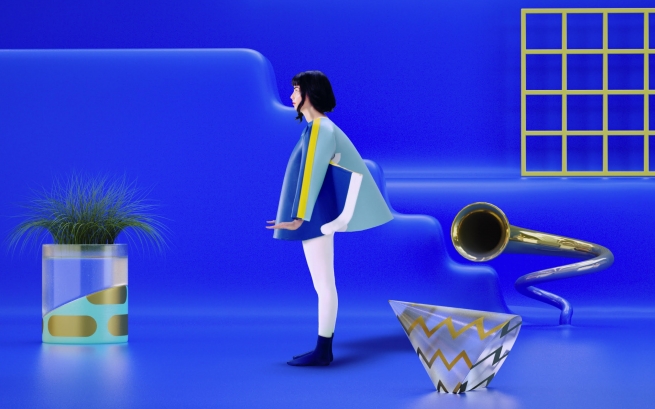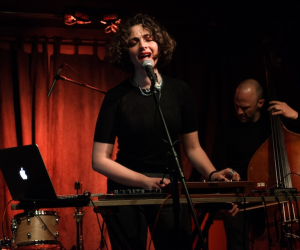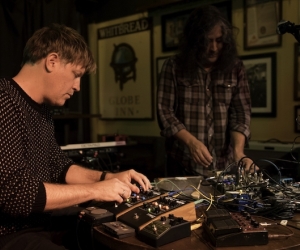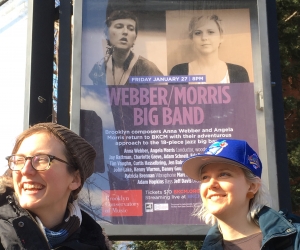
Quebec-born composer Carmen Vanderveken was commissioned by the Dutch annual festival Gaudeamus Muziekweek to write a piece for a quartet featuring Dutch bass clarinetist Fie Schouten.
An earlier piece sheds light on the shape and sound of the music Carmen Vanderveken is after. In about two and a half minutes this “very short étude,” as she calls it, skips back and forth between acoustic and electronic sounds. It is reminiscent of American composer Noah Creshevsky’s hyperrealism, but Vanderveken’s music world is one of effortless, playful grace. The acoustic sounds in the étude include a warbling flute, a clarinet in counter-movement, single notes from a singer, handclaps, some drums. There is no sharp dividing line between the acoustic and the synthesized elements. The former sound so clean that they may well have been processed. Vanderveken manages to maintain transparency in this bewildering array of components. Although the music moves through countless changes from one ultrashort fragment to the next in a state of near weightlessness, it doesn’t sound disjointed. On the contrary, there is a clear line that holds the composition together.
(The following interview has been condensed and edited.)
MUSICWORKS: How did you get to write music like this?
CARMEN VANDERVEKEN: It started two and a half years ago, at the same time as I came to the Netherlands to do a master’s in composition. At the time I already had ideas about using tools from electronic-music production and combining these with acoustic instruments, synthetic sounds, and field recordings.
MW: What kind of tools and parameters do you mean, and in what way are they part of your compositions?
CV: There’s a myriad of tools and parameters to choose from. The tools I use are equalization, reverb, compression, delay, spatialization effects—to name just a few. Among the parameters I use are the difference between “wet” and “dry,” panning, and the level of attack. I use these tools and parameters as formal elements in my compositions. They don’t stay static. All keep changing, reverb included. It is an experimental way of working, not in the sense of improvisation, but in the sense that I don’t fully know the outcome of the process.
MW: Do you have a specific sound aesthetic?
CV: I like a clean, digital, surgical sound. In my music I use synthesizers, vocals, classical instruments, and recordings from various sources. These are recorded in a transparent way with neutral equipment. I mainly focus on the higher frequencies. The instruments may acquire a virtual character. I deconstruct all these components through micro-editing. They become objects. Melody and harmony aren’t the main focus.
MW: So how do you view composition?
CV: It is combining objects. I pull things apart and build something new out of them. The pieces are not linear. There is a sense of the discontinuous. It all progresses at a fast pace. For me, five minutes—the length of the piece for the trio—is a long duration. I prefer the length of a pop song. I have a short attention span. I like surprises. My music has to keep changing. I am still figuring out what my language is. I keep questioning it a lot, but it has progressed over the years.
MW: How does that work out in the piece you are writing for Gaudeamus?
CV: I have been interested in this type of exploration from early on, even when writing instrumental scores. The music for the trio is in dialogue and synchronized with tape. Apart from Fie Schouten on bass clarinet, the musicians are Jeroen Kimman on electric guitar and Eva van de Poll on cello.
MW: Do you promote yourself and your music?
CV: I should work more to be able to present myself and my music on the Internet. I just haven’t produced enough for that. My way of working is quite time-consuming. Before something ends up in my music I throw a lot away, I keep reworking it, build it up from scratch, try to improve what I have. To realize five minutes of music currently takes two months. I am now working on an album that will be released in 2019.
MW: What music do you listen to, yourself?
CV: I don’t listen a lot. For relaxation I prefer music that is totally different from what I do. For work purposes I listen to other producers for sounds and ideas. They don’t necessarily have to be close to what I am doing. Some of them also focus on higher frequencies. The aspects of their music that I use I put together in a personal way. I do have this urge to develop a personal language. And that takes a lot of energy.
FYI: Carmen Vanderveken’s piece for Gaudeamus Muziekweek was part of a program of new works by young composers presented at the 2018 edition of the prestigious annual festival of new music held in Utrecht, the Netherlands.
Image: One frame of a music video, during work-in-progress stage, featuring composer Carmen Vanderveken, a collaborative project with 3D artist and motion-graphic designer Matthew Schoen and visual artist Nathalie Vanderveken.


